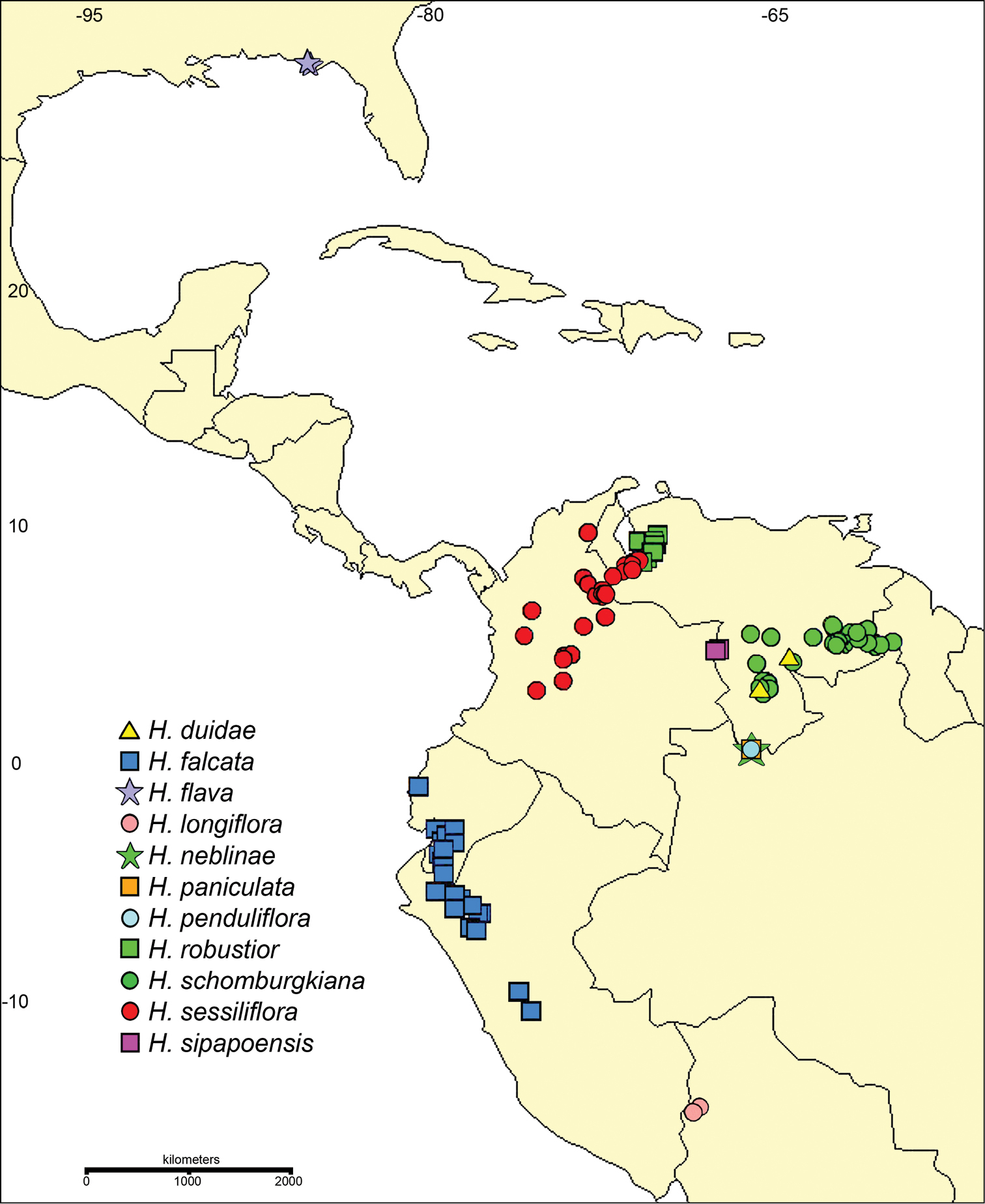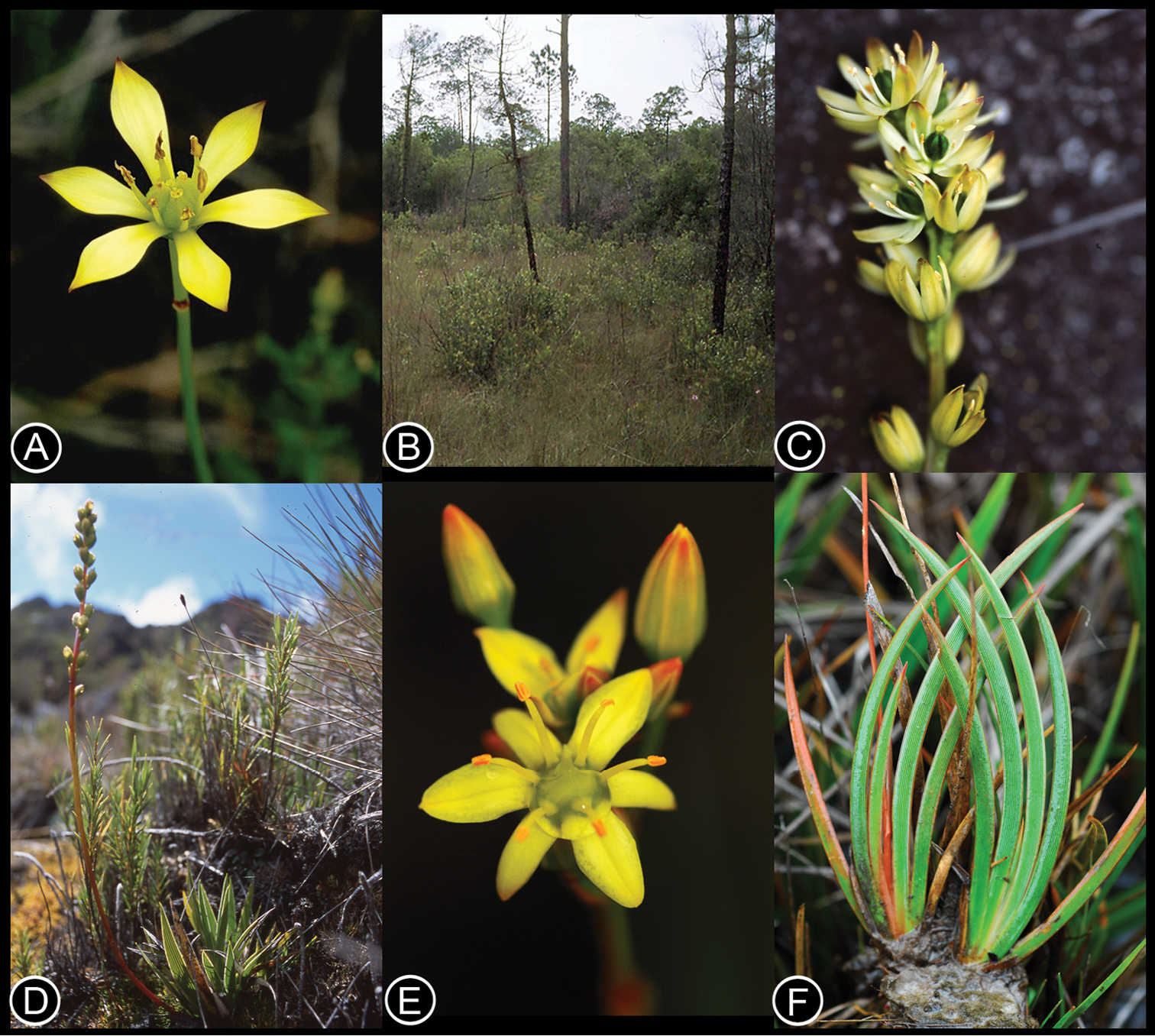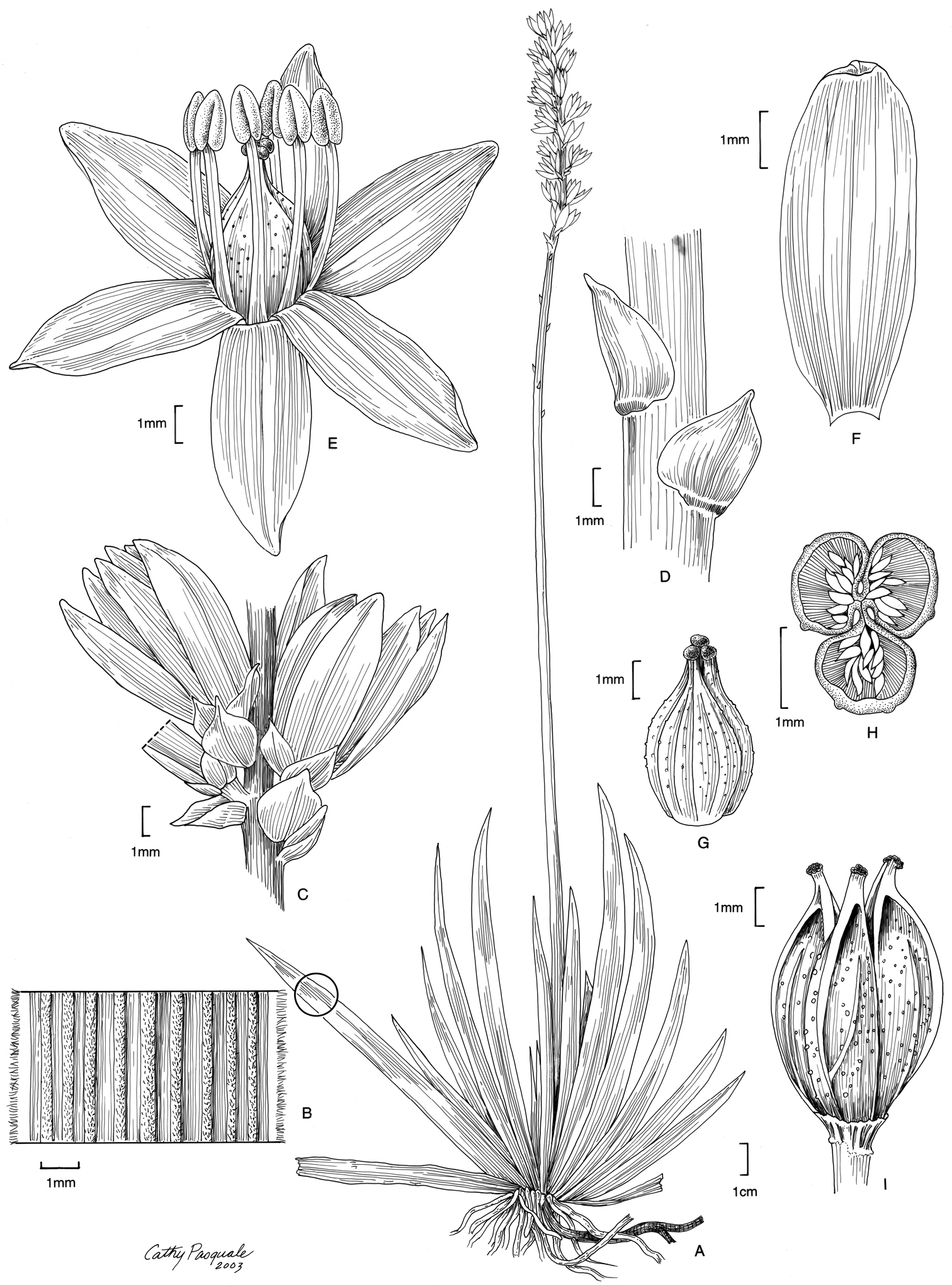






(C) 2013 Lisa M. Campbell. This is an open access article distributed under the terms of the Creative Commons Attribution License 3.0 (CC-BY), which permits unrestricted use, distribution, and reproduction in any medium, provided the original author and source are credited.
For reference, use of the paginated PDF or printed version of this article is recommended.
Ten new combinations from Asagraea, Isidrogaliva, and Tofieldia are proposed in the previously monospecific genus Harperocallis (Tofieldiaceae, Alismatales). As circumscribed here, the genus is restricted to the Americas. The majority of species occur in the Andes or the Guayana region of northern South America; more than half have restricted distributions, and Harperocallis flava is narrowly endemic in the Coastal Plain of the southeastern United States. A key to species, synonymies, distributions, representative specimens, and salient notes are presented. Populations of the species are mapped and Harperocallis robustior is illustrated. A neotype is selected for Tofieldia frigida, here considered a synonym of Harperocallis falcata. Several recent records of Harperocallis longiflora, previously known only from the type collected in 1902, are reported.
Andes, Coastal Plain, Florida, Guayana region, Isidrogalvia, monocot, nomenclature, Tofieldia
When
The nomenclatural implications of this synonymy were overlooked when the South American taxa were revised by
Due to the nomenclatural consequences of
Herbarium specimens or their images (indicated by an identifier in brackets) were examined from the following herbaria (herbarium abbreviations follow Index Herbariorum, http://sweetgum.nybg.org/ih): A, B-W (
http://species-id.net/wiki/Harperocallis
Figs 1–3Harperocallis flava McDaniel.
(modified from:
| 1 | Capsules ribbed or unribbed, well-developed lateral veins never extending to the style base | 6 |
| – | Capsules 9-ribbed, well-developed lateral veins extending to the style base | 2 |
| 2 | Inflorescence compound, the branches subtended by chlorophyllous cataphylls | Harperocallis paniculata |
| – | Inflorescence a simple raceme; peduncular bracts scarious | 3 |
| 3 | Flowers pendant | Harperocallis penduliflora |
| – | Flowers erect | 4 |
| 4 | Leaves 2.0–4.0 mm wide, usually glabrous, occasionally ciliate at the sheath apex; peduncles < 1.5 mm wide; calycular bracts longer than wide; tepals 6.0–9.0 × 1.5–2.0 mm; anthers 0.9–1.1 mm long | Harperocallis duidae |
| – | Leaves 3.0–7.0 mm wide, margin ciliolate to hirsutulous; peduncles > 1.5 mm wide; calycular bracts usually wider than long, sometimes equal; tepals 11–14 × 2–4 mm; anthers > 1.1 mm long | 5 |
| 5 | Leaves 3.0–6.5 mm wide; peduncular bracts 3–8 (–10); inflorescence ca. 9–30-flowered; tepals enclosing the rest of the flower; anthers 1.2–1.8 mm long | Harperocallis schomburgkiana |
| – | Leaves 6.0–7.0 mm wide; peduncular bracts 3 or 4; inflorescence ca. 25–40-flowered; tepals open; anthers 2.0–2.5 mm long | Harperocallis neblinae |
| 6 | Capsule incompletely 9-ribbed, well-developed lateral veins never extending to the style base | 7 |
| – | Capsule 3-ribbed or unribbed | 8 |
| 7 | Inflorescence with eglandular hairs; peduncular bracts (3–) 4–11 (–15); flowers (4–) 8–28; styles recurved, apices oblique; stigmas facing outward; capsule etuberculate | Harperocallis sessiliflora |
| – | Inflorescence glabrous; peduncular bracts 7–17; flowers 23–35; styles straight; stigmas capitate; capsule tuberculate | Harperocallis robustior |
| 8 | Leaves glabrous, veins not prominent; inflorescence 1-flowered; flower erect; ovary densely tuberculate; capsule unribbed | Harperocallis flava |
| – | Leaf margin tomentose, ciliolate or glabrous, veins prominent; inflorescence > 1-flowered, or if 1-flowered, the flower pendant; ovary not tuberculate; capsule 3-ribbed | 9 |
| 9 | Peduncular bract solitary, chlorophyllous; inflorescence 1–4-flowered; flowers pendant | Harperocallis sipapoensis |
| – | Peduncular bracts (1) 2–8, scarious; inflorescence > 10-flowered; flowers erect | 10 |
| 10 | Calycular bracts usually longer than wide (1.8–3.0 × 1.7–2.5 mm); styles 0.3–0.8 (–0.9) mm long, straight; stigmas capitate | Harperocallis falcata |
| – | Calycular bracts usually wider than long (1.5–2 × 1.8–2.3 mm); styles 0.9–1.1 mm long, recurved, apices oblique; stigmas facing outward | Harperocallis longiflora |
urn:lsid:ipni.org:names:77128356-1
http://species-id.net/wiki/Harperocallis_duidae
Based on Tofieldia duidae Steyerm.
(Fig. 1). Endemic to the Guayana Highlands of Venezuela (Amazonas and Bolívar states) where it is known only from two tepuis (Cerros Duida and Jáua); 1000–2100 m.
Distribution of Harperocallis.
VENEZUELA. Amazonas: Mpio. Atabapo, Parque Nacional Duida-Marahuaka, Macizo del Duida, 2100 m, Apr 1991, A. Fernández et al. 8094 (US); Cerro Duida, río Cunucunuma, 1000–1100 m, 18 Nov 1950, B. Maguire et al. 29515 (NY); along upper Caño Culebra, 1500–1600 m, 21 Nov 1950, B. Maguire et al. 29616 (NY, US). Bolívar: Meseta de Jáua, Cerro Jáua, cumbre de la porción Central-Occidental de la Meseta, 1922–2100 m, 22–27 Mar 1967, J.A. Steyermark 97899 (NY).
urn:lsid:ipni.org:names:77128358-1
http://species-id.net/wiki/Harperocallis_falcata
Based on Isidrogalvia falcata Ruiz & Pav.
(Fig. 1). The Andes of Ecuador (Azuay, Cañar, Loja, Morona-Santiago, and Zamora-Chinchipe provinces) and Peru (Amazonas, Cajamarca, Cusco, Huánuco, Junín, and Pasco regions); 2300–3860 m.
ECUADOR. Azuay: Cordillera Oriental, alrededores del Páramo de Patococha entre Gualaceo y Limon, 3400–3450 m, 6–7 Aug 1959, H.G. Barclay & P. Juajibioy 8632 (MO, NY); Km 85 on Pan American Highway N of Loja, 2850–2950 m, 3 May 1973, L. Holm-Nielsen et al. 4815 (MO, NY); Hac. Horta-Naque, 3100 m, 11 Jun 1946, H.N. Moldenke 869 (NY). Cañar: Cerro Yanguán NE of Pindilig, 3100 m, 13 Dec 1980, L.B. Holm-Nielsen et al. 29300 (MO, NY). Loja: Loma de Oro at Panamerican Highway, 3300 m, 2 Jan 1981, H. Balslev 1382 (MO, NY, US); Yangana–Zumba road Km 15–20, N slopes of Cordillera de Sabanilla, 2550 m, 31 Dec 1980, H. Balslev 1298 (NY). Loja/Zamora-Chinchipe: Parque Nacional Podocarpus, crest of the Cordillera de los Andes E and SE of Nudo de Cajanuma, s.d., B. Øllgaard 90768 (NY). Morona/Santiago: Gualaceo–Sigsig–Gualaquiza road, SSE of Sigsig, 03°11'S, 78°40'W, ca. 2900–3090 m, 3 Dec 1990, J.L. Luteyn et al. 14287 (NY). PERU. Amazonas: Prov. Chachapoyas: Cerca a Calla-Calla, siguiendo la ruta a Leymebamba–Balsas, 3860 m, 18 Dec 1992, I. Sanchez Vega & J. Tanta 6481 (US); Cerros [de] Calla Calla, east side, 19 km above Leimebamba [sic] on the road to Balsas, 3100 m, 4 Jun 1964, P.C. Hutchinson & J.K. Wright 5510 (NY, US). Cajamarca: Prov. Cutervo: 2350 m, 22 Jun 1992, I. Sanchez Vega & A. Miranda 6265 (NY).
When compared to its present on-line image (http://plants.jstor.org/specimen/ma810531), a photograph (F-negative no. 29435) of the lectotype of Isidrogalvia falcata taken by J. Francis Macbride of the Field Museum before World War II shows that the original label (“Isidrogalvia falcata Sp. Pl. Fl. Per. de Pillao”) was moved from the center of the specimen to the lower left-hand corner.
Tofieldia frigida was based on a collection or collections made by F.W.H.A. von Humboldt & A.J.A. Bonpland in Ecuador (“Crescit in frigidis regni Quitensis inter Loxam et pagum Ona, in summis montibus Saraguri, et Alpachacae, alt. 1200–1400 hexap, … Floret Decembri.”). While no material with this name was found in Paris (P-Bonpl.) (
http://species-id.net/wiki/Harperocallis_flava
Fig. 2A, BU.S.A. Florida: Franklin Co: 2.2 miles south of Sumatra, 11 May 1965, S. McDaniel 6205 (holotype: A; isotypes: BM, DUKE, FLAS [FLAS-97596!], FSU [000004217!], GA, M!, MO!, NCU, NY!, PH [00013616!], SMU [
(Fig. 1). Endemic to the southeastern U.S.A. where it is known only from the Apalachicola River lowlands on the Coastal Plain of the Florida panhandle (Bay, Franklin, and Liberty counties).
U.S.A. Florida: Bay Co.: North of highway 22 and east of Star Avenue, 16 May 2003, L. Keppner 37 (FSU [000081383]). Franklin Co.: 15 May 1978, A.F. Clewell s.n. (FSU [000004215]; 25 May 1979, L.C. Anderson 4875 (FSU [000004220]). Liberty Co.: North side of turn in Route 65, 1.8 miles southwest of Wilma, 8 air miles north of Sumatra, 1 May 1986, L.C. Anderson 9287 (FSU [000004223], NY); 12 May 1982, A. Gholson, Jr. et al. 9699 (FLAS [FLAS-168245], FSU [000001249]); 19 Oct 2005, L.C. Anderson et al. 23047 (FSU [000037492]). District of Columbia: U.S. Botanic Garden, Washington, cultivated from Florida, 7 Jul 2007, L.M. Campbell 1045 (NY).
Habit and habitats of Harperocallis. Harperocallis flava. A Flower (note the peduncular bract, pronounced connective, and tuberculate ovary) B Habitat. Harperocallis robustior. C Inflorescence D Habit and habitat. Harperocallis schomburgkiana. E Flower F Leaves. (A, unvouchered, photograph A.R. Schotz; B, photograph G. Anglin, C, D B. Stergios et al. 20368 (PORT), photograph K.J. Wurdack; E, F K.J. Wurdack et al. 5636 (US), photograph K.J. Wurdack).
A search of the collection and accession records of the U.S. National Herbarium (US) indicates that not all of the herbaria
urn:lsid:ipni.org:names:77128360-1
http://species-id.net/wiki/Harperocallis_longiflora
Based on Asagraea longiflora Rusby
(Fig. 1). Known only from the type locality and vicinity in Bolivia (La Paz department); 1785–2000 m.
Bolivia. La Paz: Franz Tamayo: Senda Apolo–San José de Uchupiamonas, último arroyo antes de río Huacataya, 1958 m, 8 Oct 2002, C. Maldonado et al. 3138 (MO).
Another recent collection, C. Maldonado et al. 3121, from the same locality at a slightly higher elevation (2000 m) is reported to be at LPB (see
urn:lsid:ipni.org:names:77128371-1
http://species-id.net/wiki/Harperocallis_neblinae
Based on Isidrogalvia neblinae Steyerm. ex L.M. Campb.
(Fig. 1). Known only from Cerro de la Neblina in the Guayana Highlands of Venezuela (Amazonas state); 1700–2100 m. This species is expected to occur also in the Brazilian part of the massif (Amazonas state).
VENEZUELA. Amazonas: Mpio. Río Negro, Cerro de la Neblina, altiplanicie en la cumbre del brazo noroccidental, al norte del campamento base a lo largo del Río Mawarinuma, afluente del Río Baria, aprox. 0°52–53'N; 66°05'W, 1880 m, 7–8 Feb 1984, J.A. Steyermark & J.L. Luteyn 129828-A (VEN-unicate); 4–6 km northeast of Cumbre Camp, 2100 m, 20 Nov 1957, B. Maguire et al. 42154 (NY); Ridge at divide between Brazil and Venezuela, 26 km east-northeast of Neblina base camp, ca. 0°53'N, 65°56'W, 2000 m, 15 Apr 1984, T. Plowman & W.W. Thomas 13594 (F).
urn:lsid:ipni.org:names:77128372-1
http://species-id.net/wiki/Harperocallis_paniculata
Based on Isidrogalvia paniculata L.M. Campb.
(Fig. 1). Known only from Serra da Neblina in Brazil (Amazonas state); 2600–2700 m. This species may occur also in the Venezuelan part of the massif (Amazonas state).
urn:lsid:ipni.org:names:77128373-1
http://species-id.net/wiki/Harperocallis_penduliflora
Based on Isidrogalvia penduliflora L.M. Campb.
(Fig. 1). Known only from the vicinity of the type locality in the Guayana Highlands of Venezuela (Amazonas state); 1800–2100 m. This species likely occurs also in the Brazilian part of the massif (Amazonas state).
VENEZUELA. Amazonas: Mpio. Río Negro, Neblina massif, camp II, 2.8 km NE of Pico Phelps (= Neblina), on plateau, 0°49'40"N, 65°59'W, 2085–2100 m, 17 Mar 1984, B.L. Stannard 166 (VEN); S.S. Renner 2026 pro parte (MO [1434169]).
urn:lsid:ipni.org:names:77128374-1
http://species-id.net/wiki/Harperocallis_robustior
Figs 2C, D, 3Based on Tofieldia sessiliflora var. robustior Steyerm.
(Fig. 1). Andes of Venezuela (Lara, Mérida, and Trujillo states); 2200–3700 m.
Venezuela. Lara: Mpio. Moran, below Páramo Las Rosas, 2285–3290 m, 25 Jun 1979, R. Liesner et al. 7965 (MO, NY). Mérida: Mpio. Rangel, Cerro el Guamo, 3100–3200 m, 19 Jun 1988, L.J. Dorr & L.C. Barnett 5627 (NY). Trujillo: Páramo de Cachaco, 3400–3700 m, 7 Nov 1927, P. Christ 84 (NY); Mpio. Boconó, Páramo de Guaramacal, ca. 3080 m, ca. 9°14'N, 70°11'W, 28 Apr 1988, L.J. Dorr et al. 4967 (NY, PORT); Páramo de Guirigay, 3000 m, 22 Apr 2002, L.J. Dorr et al. 9200 (NY, PORT, US); Parque Nacional Guaramacal, vertiente norte, ca. 1977–2350 m, 28 Apr 1998, B. Stergios et al. 17327 (PORT-unicate); Laguna Larga via Laguna Las Parias to Laguna Eco, Páramo de Motumbo, 2400–2600 m, 15 Sep 2003, B. Stergios et al. 20368 (F, MO, NY, PORT, US).
Harperocallis robustior. A Habit B Leaf (detail of parallel veins and tomentose margins) C Inflorescence (detail showing peduncular and calycular bracts subtending flowers) D Peduncular bracts (detail) E Flower F Tepal (adaxial view) G Ovary (note the tuberculae) H Ovary (cross-section showing axile placentation and ovules) I Capsule (carpels separating distally). (A, I from L.J. Dorr et al. 4967 (US); B–H from B. Stergios et al. 17327 (PORT).
urn:lsid:ipni.org:names:77128375-1
http://species-id.net/wiki/Harperocallis_schomburgkiana
Fig. 2E, FBased on Tofieldia schomburgkiana Oliv.
(Fig. 1). Guayana Highlands of Venezuela (Amazonas and Bolívar states) and adjacent Guyana; 1430–2800 m.
GUYANA. Cuyuni-Mazaruni Region: Mt. Maringma, summit, 2110 m, 15 Jun 2004, H.D. Clarke et al. 11717 (MO, NY, US); Paruima, 20 km W, Waukauyengtipu, 1430 m, 18 Jul 1997, H.D. Clarke et al. 5855 (NY); Below 1st escarpment (of four) of Kamakusa Mt., 0–1 mi. SW of Ducking (1st) Camp [heading] to savanna, 5°45'58.9"N, 60°15'57.6"W, 637m, 15 May 2012, K.J. Wurdack et al. 5636 (US). Upper Takutu- Upper Essequibo: Mount Roraima, summit, Autumn 1898, J.J. Quelch & F. McConnell 657 (NY). VENEZUELA. Amazonas: Mpio. Atabapo, Cerro Marahuaca-Atuhua-Shiho, cumbre, parte aislada al Sur-Oeste del Cerro, 2450–2480 m, 9–10 Feb 1982, J.A. Steyermark et al. 124367 (MO, NY), cumbre, sección noroccidental, 2500 m, 16 Feb 1981, J.A. Steyermark et al. 124393 (MO, NY); Caño Sapo, summit of Mount Duida, 1920 m, Aug 1928 to Apr 1929, J.A. Steyermark 690 (NY). Bolívar: Cerro Guaiquinima, Río Paragua, 1800 m, 29 Dec 1951, J.J. Wurdack 32817 (MO, NY); North Valley, 1600–1700 m, 10–12 Jan 1952, J.J. Wurdack 33039 (NY); macizo del Chimantá, sección nor-oriental del Acopan-tepui, 1950 m, 8–11 Feb 1985, J.J. Pipoly et al. 7207 (NY).
urn:lsid:ipni.org:names:77128376-1
http://species-id.net/wiki/Harperocallis_sessiliflora
Based on Tofieldia sessiliflora Hook.
(Fig. 1). Andes of Venezuela (Mérida and Táchira states) and Colombia (Antioquia, Boyacá, César, Cundinamarca, Huila, Magdalena, and Norte de Santander departments); 2500–3200 m.
VENEZUELA. Mérida: Páramo de los Conejos, 3300 m, 24 Jun 1953, L. Bernardi 685 (NY); Mpio. Rivas Dávila, 25 km NE of La Grita, 2830 m, 15 Apr 1984, J.L. Luteyn & M. Lebrón-Luteyn 9928 (NY). Táchira: NE side of Páramo de Táma, 2900–3200 m, 18 Oct 1978, J.L. Luteyn et al. 5906 (MO, NY, US). COLOMBIA. Boyacá: Cordillera Oriental, Páramo de Belén, 3150 m, 6 May 1959, H.G. Barclay & P. Juajibioy 7564 (MO, NY). Cundinamarca: Chapinero, near Bogotá, 3000–3100 m, 18–23 Sep 1917, F.W. Pennell 2013 (NY, US). Huila: Río Balsillas, 2100–2200 m, 3–5 Aug 1917, H.H. Rusby & F.W. Pennell 756 (MO, NY-2 sheets, US). Magdalena: Sierra de Perijá, east of Manaure, Sabana Rubia, 3000–3100 m, 6 Nov 1959, J. Cuatrecasas & R. Romero Castaneda 25040 (US). Norte de Santander/César: Cerro de Oroque, 3700–3960 m, 19–21 May 1969, H. García-Barriga & R.J. Mejía 19740 (NY, US).
urn:lsid:ipni.org:names:77128377-1
http://species-id.net/wiki/Harperocallis_sipapoensis
Based on Isidrogalvia sipapoensis L.M. Campb.
(Fig. 1). Known only from Cerro Sipapo in the Guayana Highlands of Venezuela (Amazonas state); 1500–1700 m. This species likely occurs also on the geologically and floristically similar Cerro Autana, which is near the type locality.
VENEZUELA. Amazonas: Mpio. Atures, areniscas del Cerro Cuao, Caño Cabeza de Manteco, 73 km SE de Pto. Ayacucho, 5°06'N; 67°24'W, 1580 m, Sep 1989, A. Fernández et al. 6207 (MO, NY, PORT); Serranía Sipapo, cumbre, 5°N; 67°30'O, 1500 m, 17 Feb 1981, J.A. Steyermark et al. 124556 (VEN).
Isidrogalvia borealis Ruiz & Pav. ex Steud., Nomencl. Bot. 839. 1821., nom. nud., pro syn. = Tofieldia palustris Huds.
We especially appreciate the assistance of Rose Gulledge (US) who prepared the map and arranged the figures. We thank Cathy Pasquale for preparing the illustration of Harperocallis robustior; Donald Wheeler (Mertz Library, NY) for providing critical literature; Andres Botero (NY) for technical assistance; Brett Jestrow (FTG) for providing a specimen image; Kenneth Wurdack (US) for sharing photographs; the curators and staff at A, B, BC, BM, BRIT, F, FLAS, FSU, GH, K, MA, MO, NY, P, PH, PORT, US, and VEN for access to their specimens; and Wendy Zomlefer (GA) for a critical review of the manuscript.


